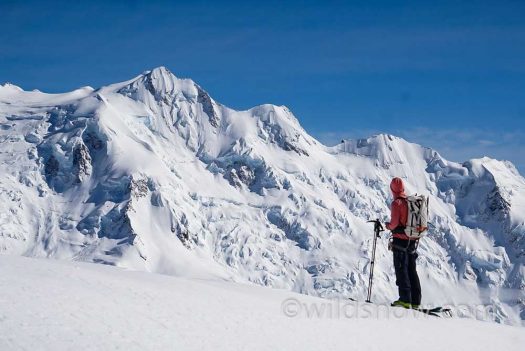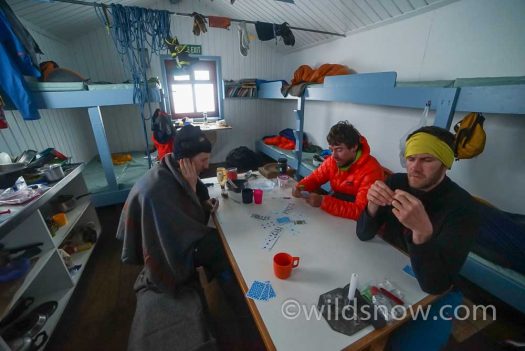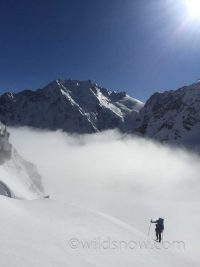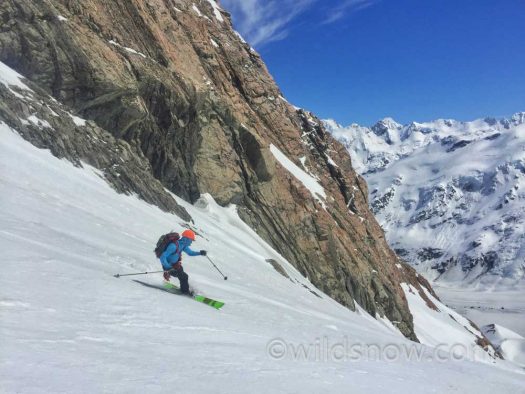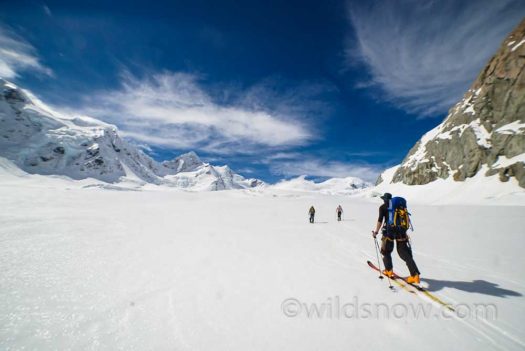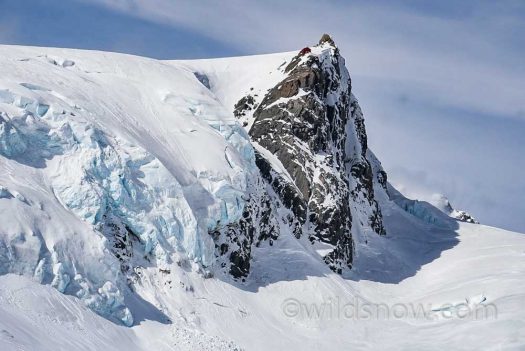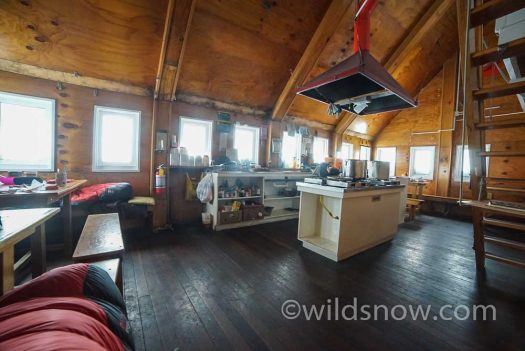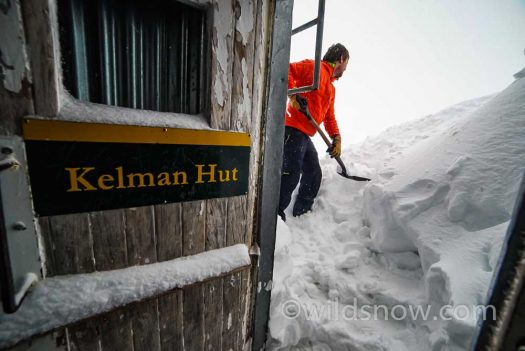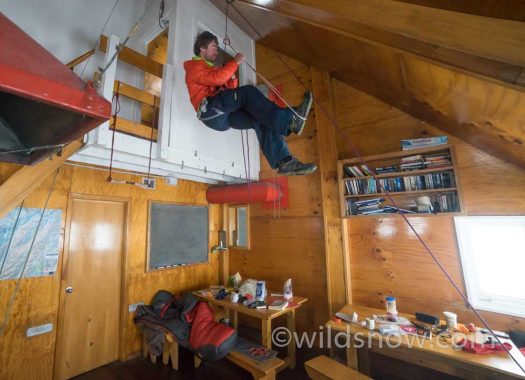“Hey Louie, what are the odds you’ll eat a heaping spoonful of dry milk powder?”
Yep, the cyclical, cynical humor days of hunkering down waiting out storms are all too familiar. The critical difference this go around is the abundance of well built huts in this otherwise inhospitable place. In most ways better than a tent, though lacking in the excitement thin nylon walls can induce.
This dispatch is mostly recorded at the Kelman Hut, also known as the “Fridge on the Ridge”. We’ve dubbed it the “Kilton” (Kelman Hilton) because of the relative amenities that are included.
We are approaching a week on the upper Tasman Glacier and have skied about three days. Our initial arrival was as exciting as they come. A rapid progression of events led us to a ski plane in a flurry of moderate organization. The flight itself was relatively short, but there is something so unique and awe-inspiring about flying through a mountain range in a small single prop plane and touching down on a glacier. Teleportation.
Of course, to the seasoned Kiwi alpinists and skiers in the Aoraki/Mt. Cook National Park, this is the norm. I like to remember to approach these experiences with a beginner’s mind; never take opportunities for granted. This is exasperated by the gigantic moraine walls and changing glaciation that make the foot travel in and out look, to put it kindly, daunting.
Anyways, our late afternoon touchdown landed us in different terrain with a very different set of snow conditions. We dropped our overnight gear and food at the Tasman Saddle Hut and hung out for an hour before heading out for an evening ski of the nearby Hochstetter Dome. In general, I’ve tried to keep my expectations of the snow conditions low, this way I can capitalize on pleasant surprises. The southwest slopes of the peak provided an engaging mix of patches of ice separated by islands of wind buffed powder. Nonetheless, beautiful views and fun turns had us back at our perch on the point in time for a late meal.
We shared the ~15 person hut with four other folks, two Kiwis, and two Frenchies who are living in NZ. Louie and I missed the daily Department of Conservation (DOC) radio check-in with the weather forecast and noted intentions. Our hut mates happily passed on the grim forecast for the following day and we all mentally settled into a day of hunkering down.
I’ve always heard about the Southern Alps’ wind, consistently blowing 80-100kph. We experienced this from our incredibly exposed perch in the Tas Saddle Hut. Louie and I nervously joked about a report we had read about a hut getting blown off a mountain side with four people still inside it.
The crux of our one day storm at the Saddle Hut was definitely the Hut-Toilet Traverse. I’d call it NZ Grade 18 (I actually don’t know anything about the NZ T grading scale, anyone care to enlighten?), with extreme exposure. The difficulties are highly subjective, depending largely on type of protection utilized and the laziness in one’s footwear choice. I opted for an ice tool to offset the slick trail runners on the feet. The route is about 10 meters in length across a section about 7 meters wide, all highlighted by 200-300 meter drop-offs on either side. In all seriousness, a loss of footing in the strong gales that roar through here would certainly be fatal. Most parties opt to fix a line between the two structures: highly recommended!
With a somewhat promising weather window on the menu, we all planned to set out for a ski in a nearby cirque in the Malte Brun Range up the Darwin Glacier. The Frenchies and the Kiwis headed to Mt. Hamilton, while Louie and I would veer off towards Malte Brun to keep group sizes (and decision making complications) to a minimum.
We left the hut in calm wind and an unreal sunrise, but quickly noticed a large cloud bank reaching up for us from the lower Tasman Glacier. Twenty minutes of observations and “hmm-ing and hah-ing” we made the counter-intuitive decision to drop in to the white-out. Skiing by braille in the ping-pong ball is what dreams are made out of, but thankfully we eventually dipped below the ceiling and skied 7km down to the Darwin junction on the largest ice rink I’ve ever been on.
vertical
The clouds were actually a saving grace as the sun quickly took a toll and heated things rapidly. We were still gathering info on conditions and adjusting to a new snowpack, so the rapid rise in the temperature gave us pause at what to ski. We noticed a couloir on Malte Brun that was guarded about half way up by a short rock band and ice bulge, but it looked manageable. The couloir was partially shaded, but heading into the northwest facing sun. We opted to avoid the objective hazard and climb up the short slope to the summit of nearby Rumdoodle (yes, that’s legit). We were humbled about half way up the face by hard ice that covered the whole slope. It was appearing that the wind had done a number on conditions.
Bailing back down to the upper glacier, we were feeling a bit discouraged by steeper skiing possibilities. Fortunately, the consolation prize was 1000 meters of corn skiing in a truly spectacular setting down the Turnbull Glacier.
We navigated a short moraine wall crux and landed back on the expansive Tasman Glacier. We sat and admired the few glacial tour flights that landed with groups of folks ill equipped for more than 20 minutes on the neve. We laughed at the odd occurrence of hearing a baby crying in the distance, and suddenly we felt a little closer to civilization.
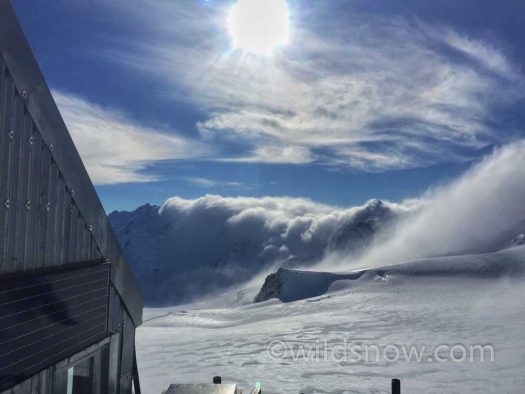
Louie and I made a quick detour to the Kelman Hut to scope the amenities and free hut food offerings. Pretty wild how quickly the clouds can roll in over the divide.
Our international friends arrived at the Darwin-Tasman junction, and we had a social slog back up to the Tasman Saddle admiring the grand scale of the place.
Back at the Tasman Saddle Hut we all listened in to the radio as DOC called in with another deteriorating forecast. Everyone else was planning to head out, while Louie and I remained indecisive about whether a 3/4 day of decent weather was worth it. We decided to roll the dice and stay and play. The following morning had us making a sunrise trek to the nearby “Kilton” to drop our overnight stuff and head into the upper Murchison Glacier area.
With the hopes of new terrain and big skiable lines we were excited to stretch the legs some more before an impending nor’wester would come in and pin us in the “Fridge on the Ridge”. We made a dash to nearby Brodrick Peak. After some fun ridge navigation we made it about 250 meters from the top and were once again in a complete whiteout. It’s always tricky exploring a new area and having to learn through experience which peaks act as catchers mitts for approaching weather. Brodrick was the catcher, and we were once again denied the opportunity to stand on top of something. A similar consolation prize brought us back to the Murchison Glacier and pondering plans for the remaining hours of decent weather.
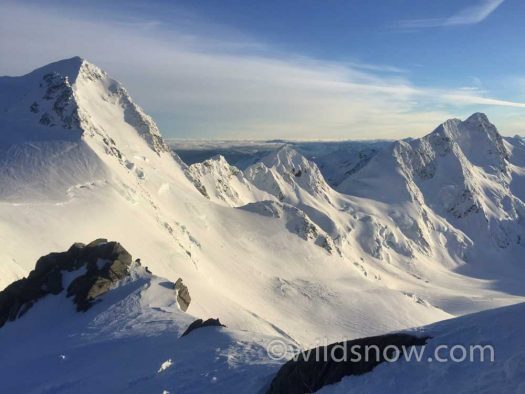
The view from the porch of the Kelman Hut, looking at the Murchison headwall and Brodrick on the far right.
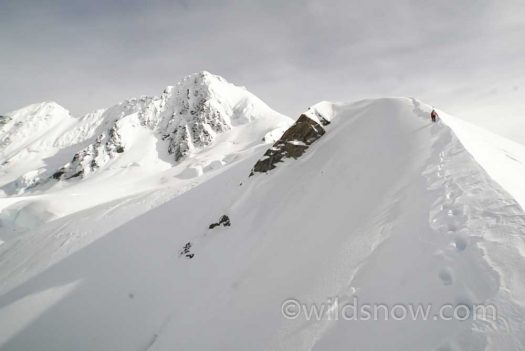
Working up one of the ridges towards the top of Brodrick before we were completely shrouded in clouds.
Mt. Cooper looked appealing, so we journeyed up the east ridge above the, now closed, Murchison Hut. The hut has apparently shifted 9 meters laterally and down the slope, which is due to the entire hillside moving from glacial recession. Still intact and unlocked, but deemed unsafe by the cautious DOC.
We cramponed up the face and ridge in an increasing wind that pushed us off our stance a few times. It was 2:15 in the afternoon and the forecasted precip and whiteout was here to stay. Yet again, 100 meters below the summit we bailed and felt our way down to the glacier in zero visibility.
The long blind slog back to the Kelman Hut was managed by the promise of endless propane stoves and free hut food for the taking.
The last 2 days have been a hilarious mix of puttering around, playing multiple games of Monopoly, and curating concoctions of snacks based on what others have left behind. Being storm bound in confined spaces always fascinates me on a social psychology level, and I think would be entertaining as reality TV. Or maybe hut life needs to be preserved as a sacred space for the psyche.
Soon, we’d decided to make a break for it and escape the “Kilton.” More whiteout skiing through breakable rain crust got us down to the dry ice landing zone. We were able to group up with the two climbers we shared the hut with, and piggyback on a speedy airlift out to avoid the moraine bashing. So far, NZ continues to be good, while “varied.” What a wonderful country.

Jonathan Cooper (“Coop”) grew up in the Pacific Northwest and has been playing in the mountains since he was a teen. This was about the same time he made the fateful decision to strap a snowboard to his feet, which has led to a lifelong pursuit of powdery turns. Professionally speaking, he has been working as a ski guide, avalanche educator, and in emergency medicine for over a decade. During the winter months he can be found chasing snow, and passing on his passion for education and the backcountry through teaching avalanche courses for numerous providers in southwest Colorado, and the Pacific Northwest. Similarly, his passion for wilderness medicine has led him to teach for Desert Mountain Medicine all over the West. If you’re interested, you can find a course through Mountain Trip and Mountain West Rescue. In the end, all of this experience has merely been training for his contributions to the almighty WildSnow.com.

